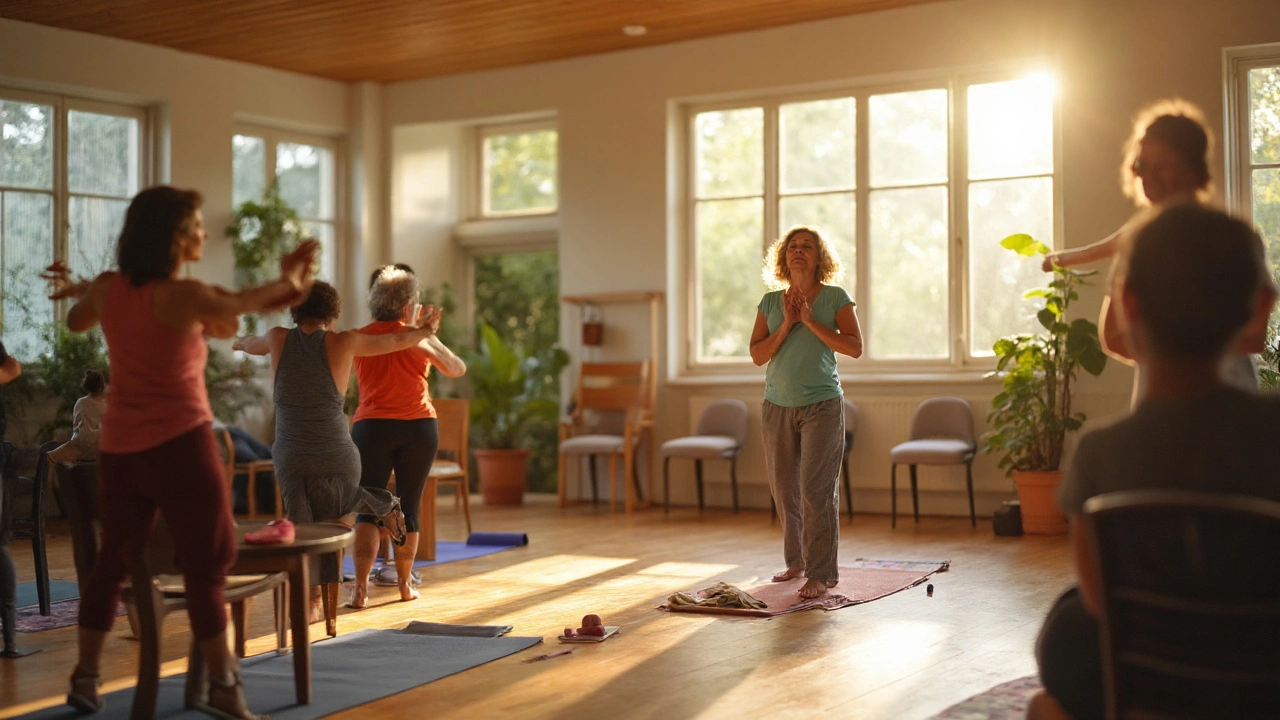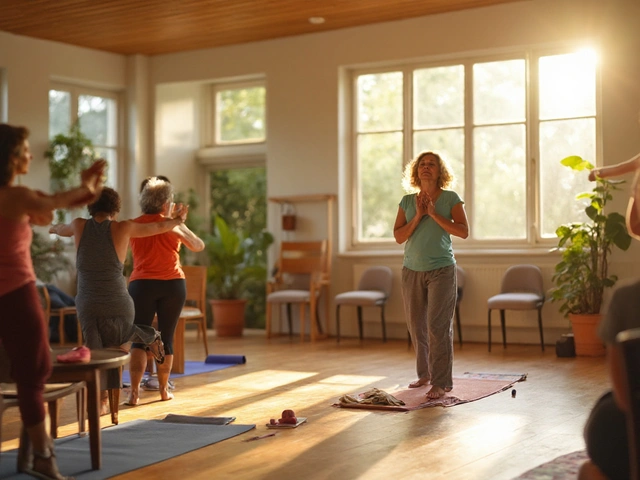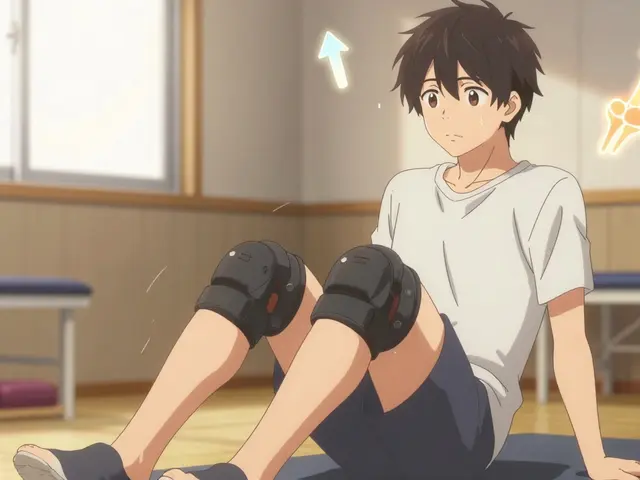You feel the floor shift, your vision swims, and your body tenses. Dizziness can hijack your day in seconds. Here’s the good news: yoga and meditation won’t cure every cause, but they can calm the nervous system fast, reduce anxiety that worsens spinning, train steadier balance, and help your body handle posture changes without freaking out. Expect relief, not magic. For issues like BPPV, you still need the right maneuver (like Epley) from a clinician, but the tools below make symptoms lighter and shorter for many people.
TL;DR: Quick Wins and What to Expect
- What helps now: slow nasal breathing (3-3-6), seated grounding, soft eye focus, and gentle neck/shoulder release. These can cut the “panic-amp” that turns lightheaded into a full spin.
- What helps long-term: 10-15 minutes a day of balance-friendly yoga, gaze-stability drills, and short mindfulness practice. This builds steadier reflexes and tones down threat signals.
- Who benefits most: people with anxiety-linked dizziness, PPPD-like symptoms, vestibular migraine, mild residual dizziness after an inner ear event, deconditioning, or orthostatic intolerance.
- Who needs medical care first: sudden severe vertigo with hearing loss or new neuro symptoms; fainting; chest pain; head injury; new continuous vertigo; frequent falls. Call urgent care/911 for red flags.
- Timeline: some feel calmer within minutes; balance gains usually show in 2-4 weeks; migraine-related dizziness often needs 6-8 weeks with steady practice.
One search note: if you came looking for yoga for dizziness routines, you’ll find a safe starter plan below with poses, breathwork, and when to skip certain moves.

A Step-by-Step Plan to Use Yoga and Meditation During and Between Dizzy Spells
We’ll split this into two parts: what to do during a spell (to settle your system) and what to do daily (to lower the chance and intensity of future spells). No fancy gear. A chair, a wall, and maybe a folded towel are enough.
During a spell (3-7 minutes)
- Sit and ground. Sit on a chair with your feet flat and knees hip-width. Place your hands on your thighs. Press your feet gently into the floor for 5 seconds, release for 5. Repeat 3 times. This tells your brain, “I have stable contact.”
- Soften the eyes. Don’t clamp your eyes shut. Pick a still spot at eye level about 1-2 meters away. Keep a soft gaze. If the room moves, hold the spot and let the background drift-don’t chase it.
- 3-3-6 breathing. Inhale through the nose for 3, hold for 3, exhale for 6. Do 6-8 rounds. Longer exhales tap the brake on your stress response.
- Neck/shoulder reset. Shrug shoulders up for 3 seconds, release fully. Do 5 times. Then, tiny chin nods (like saying “yes”) 8-10 times. Skip if any neck pain or if it worsens symptoms.
- Optional: palm press. Press palms together at chest height for 5 seconds, release 5. Repeat 3 times. Light isometric work steadies blood pressure in some folks who get woozy on standing.
Most people feel calmer by the end of the second breathing cycle. If you’re still spinning hard after 10 minutes or you feel faint, lie on your side and call for help if needed.
Your 10-minute daily practice (steady gains, low risk)
- Boxed breath primer (2 minutes). Inhale 4, hold 4, exhale 4, hold 4. Do 8 rounds. It’s simple and trains breath control without lightheadedness.
- Seated cat-cow (1 minute). Hands on knees, slow spine flex and extend with breath. Keep the head level-no big head drops.
- Wall mountain (Tadasana) with heel rock (2 minutes). Stand at a wall, light fingertip touch. Rock weight from heels to midfoot and back. Small range. Eyes on a still spot. This rehearses balance with a safety net.
- Chair-supported lunge (2 minutes). One foot forward, one back, hands on chair. Shorten the stance if dizzy. Bend the front knee a little and breathe. Switch sides. Builds leg strength without head tipping.
- Modified tree pose at wall (2 minutes). Stand side-on to a wall, touch with one hand. Place the other foot to ankle or calf (not knee). Pick a visual target. Hold 20-30 seconds each side. Step down if symptoms rise above 4/10.
- Two-minute mindfulness. Sit or lie down. Eyes soft. Notice breath at the nostrils. Label thoughts “thinking” and return to breath. Simple, not perfect.
Your 20-minute upgrade (3-4 days a week when you’re ready)
- Start with the 10-minute plan. Add: hip hinge work (chair-supported half forward fold), gentle thoracic rotation (seated twist without turning the head far), and 3 sets of VOR x1 gaze drills (see below). Finish with a 5-minute body scan.
VOR x1 gaze stability drill (the vestibular classic, made yoga-friendly)
- Hold a target (thumb or sticky note with a letter) at arm’s length, eye level.
- Keep eyes glued to the target while you turn your head left-right about 20 degrees at 1-2 beats per second. If you can’t keep it clear, slow down or make the movement smaller.
- Do 30-45 seconds, rest 30 seconds. Repeat facing a blank wall to reduce visual clutter. Start seated if standing feels wobbly.
Why include VOR? It trains the reflex that keeps vision stable when your head moves. Many people with vestibular issues feel less bouncy vision after 2-3 weeks of short, frequent sets.
Short meditations that help dizziness-prone brains
- 5-4-3-2-1 grounding (1-2 minutes). Name 5 things you see, 4 you feel, 3 you hear, 2 you smell, 1 you taste. It cuts through spiraling worry fast.
- Counting breaths (3-5 minutes). Count each exhale up to 10, then restart. If you lose count, cool-just start over.
- Body scan (5 minutes). Move attention from toes to head, noticing tension and softening it. If scanning the head triggers symptoms, stop at the shoulders.
Poses to use-and poses to treat with care
- Use: mountain, chair pose (light), supported lunge, low crescent with hands on blocks, bridge on a block (hips slightly raised), side-lying clamshells, supine hamstring stretch with strap, modified tree, warrior 2 with short stance.
- Treat with care (or skip until steady): deep forward bends, fast transitions, long holds with head below heart, full inversions, camel and wheel, eyes-closed balance work. If you have BPPV, avoid sudden head tipping back or rolling to the problem side until treated.
Rules that keep you safe
- Symptom scale: keep moves at or under 4/10 symptoms. If you hit 5+, pause, breathe, and reset. Tiny exposures beat heroic efforts.
- Two points of contact: hands on a wall or chair during balance work until you barely need them. Pride is overrated; stability works.
- Eyes before head: aim your eyes first, then turn your head. It’s smoother on the system.
- Breath stays quiet. If you feel air hungry or dizzy from breathwork, shorten the hold or drop holds altogether and just lengthen the exhale.

Tools, Checklists, Evidence, and Safe Modifications
Here’s where we make it practical: what to watch for, how to tailor by cause, and what the research actually says.
Quick decision guide: match your pattern to your plan
| Dizziness pattern | Common clues | Helps most | What to avoid early | Evidence snapshot |
|---|---|---|---|---|
| BPPV (benign paroxysmal positional vertigo) | Spins with rolling in bed, looking up; lasts seconds | Repositioning (Epley/Semont) by trained clinician; gentle breathwork for calm; steady walking after treatment | Head-hanging or quick head turns until treated; deep backbends | AAO-HNS BPPV guideline (2017) supports repositioning maneuvers as first-line |
| Vestibular neuritis/labyrinthitis recovery | Sudden severe vertigo, then lingering imbalance; worsens with head movement | Gaze stabilization (VOR x1), graded head motion, simple yoga for strength and posture | Long rest without movement; jolting classes | Cochrane Review (2022) supports vestibular rehab exercises |
| PPPD / anxiety-linked dizziness | Rocking/swaying, worse in busy visuals, better when distracted | Mindfulness, breath control, graded exposure in safe settings, simple balance drills | Avoidance that shrinks your world; eyes-closed balance too soon | Emerging trials show CBT/mindfulness reduce symptom burden |
| Vestibular migraine | Dizziness with/without headache, light/noise sensitivity, triggers like sleep loss | Trigger management, consistent breathwork, gentle yoga, VOR as tolerated | Overheating rooms, strong scents, fast flows on bad days | Clinical studies support stress reduction and graded activity in migraine care |
| Orthostatic intolerance / POTS-like | Woozy on standing, fast heart rate upright, better lying down | Supine/seated yoga, isometrics, paced breathing, slow stand-ups, fluids/salt as advised by your clinician | Hot rooms, long static standing, fast transitions | Pilot trials show breath and recumbent exercise improve tolerance |
| Deconditioning | Reduced activity, general weakness, worse with effort | Short daily sessions, leg/hip strength, walk breaks, consistent sleep | All-or-nothing workouts | Exercise physiology research supports gradual, frequent practice |
Checklist: your safe practice setup
- Pick a quiet, cool room; bright, flickery lights can trigger symptoms.
- Have a wall and a sturdy chair within reach at all times.
- Eat a light snack and drink some water 30-60 minutes before if you tend to get woozy.
- Set a 10-15 minute timer so you don’t chase the clock.
- Keep a paper “symptom ladder” (0-10) to track how moves feel. Stop at 5.
Checklist: progress tracker (2-minute journal)
- Rate your worst daily dizziness (0-10).
- Note triggers (shops, screens, turning fast, standing up).
- Write which moves felt best today.
- Add one tiny progression every 3-4 days (e.g., 5 more seconds of VOR, hand off the wall for 3 breaths).
Common pitfalls
- Doing “yoga as usual.” Hot studios, inversions, and fast flows are not friendly while dizzy. Keep it cool, slow, and supported.
- Training only when you feel good. Your nervous system learns best with tiny, safe doses even on meh days.
- Skipping head motion forever. Gentle, graded head turns matter for long-term steadiness-just keep them small and controlled.
- Holding breath. Breath-holding can spike symptoms. Smooth, quiet nasal breathing is your anchor.
Mini-FAQ
How long until I notice less dizziness? Many people feel calmer during the very first breathing set. Balance and gaze stability usually improve within 2-4 weeks of short daily practice.
Can I do this with BPPV? Yes, but first get the right repositioning maneuver from a clinician. Avoid head-hanging poses until the crystals are moved back where they belong.
What if breathwork makes me lightheaded? Drop breath holds. Use simple 4-in, 6-out nasal breathing. Sit or lie down while you practice.
Is it safe for older adults? Yes when supported. Use a wall/chair, skip fast transitions, and keep eyes on a steady visual target.
Morning or night? When you’ll actually do it. Many find mornings set a calmer baseline; a 3-minute evening body scan can also settle the system for sleep.
Should I practice during a migraine? Keep it very gentle: quiet room, cool compress, soft breathing, and maybe a short body scan. Save balance work for later.
Evidence, in plain English
- Vestibular rehab works for peripheral inner-ear problems. A Cochrane Review (2022) found that gaze-stability and balance exercises reduce dizziness and improve function.
- Mindfulness lowers anxiety and stress reactivity. A large meta-analysis in JAMA Internal Medicine (Goyal et al., 2014) showed meaningful reductions in anxiety and depression versus usual care.
- Yoga helps balance and reduces fear of falling in older adults. Reviews in geriatric and rehab journals have reported small-to-moderate improvements in balance measures with gentle yoga.
- BPPV has a best treatment: repositioning maneuvers. The American Academy of Otolaryngology-Head and Neck Surgery guideline (2017) recommends canalith repositioning as first-line.
- Paced breathing improves autonomic tone. Clinical physiology studies show longer exhales and slow nasal breathing increase heart rate variability, a sign of better “rest-and-digest” balance.
These findings don’t make yoga or meditation a cure-all. They suggest why a calm, graded routine helps many people feel steadier faster, especially alongside medical care when needed.
Persona-based next steps
If you’re anxious and new to this: Do the 10-minute plan only, five days a week, for two weeks. Keep every move under 4/10 symptoms. If you feel unsure, do every balance pose with one hand on a wall.
If you have vestibular migraine: Practice in a cool, scent-free room. Keep lights soft but steady (no flicker). Start with breathing + seated cat-cow + supported lunge + 2 short VOR sets. Skip on high-symptom days or cut volume in half. Protect sleep and hydration-it matters as much as the routine.
If you’re older or have a fall history: Wear supportive shoes. Always have a chair in front and a wall behind. Keep stances shorter. Add sit-to-stands from a chair (5-10 reps) to build leg strength.
If you get woozy on standing (orthostatic intolerance): Do most of your routine seated or lying down at first. Use isometrics (palm press, thigh press) and paced breathing. When you stand, rise in stages: sit → edge of seat → half-stand → stand. Sip water and talk with your clinician about fluids and salt.
When to stop and call a clinician fast
- Sudden severe vertigo with hearing loss, double vision, slurred speech, weakness, or numbness.
- Fainting, chest pain, severe shortness of breath.
- Head injury or new continuous vertigo that doesn’t ease.
- Vertigo so strong you can’t walk safely.
A simple weekly plan you can repeat
- Mon/Wed/Fri: 10-minute routine + 2 VOR sets + 2-minute body scan.
- Tue/Thu: 10-minute routine + gentle walk (10-20 minutes) watching a steady point ahead.
- Sat: 20-minute upgrade if you’re feeling steady.
- Sun: Rest or only 3-5 minutes of breathwork.
Tiny progressions (every 3-4 days if symptoms stay under 4/10)
- Tree: move from hand-on-wall to fingertip touch to hand hovering for 3 breaths.
- VOR: add 5 seconds per set or widen the head turn by 5 degrees.
- Lunge: lengthen the stance by one foot-length or add 2 slow pulses.
- Breath: add one extra exhale beat (6 → 7) if it feels comfortable.
What if a move spikes symptoms?
- Pause and breathe for 30-60 seconds. If you settle, try a smaller range or slower pace.
- If two tries still feel rough, swap the move: do seated heel-toe taps or side-lying clamshells instead of standing balance that day.
- Note it in your journal. Try again in 3-4 days.
Gear you might like (but don’t need)
- Yoga blocks or thick books to bring the floor closer.
- Non-slip mat and a stable chair.
- Eye-level sticky note target for VOR drills.
Stick with this plan for two weeks and re-rate your worst daily dizziness. If the number hasn’t budged at all, loop in your clinician. You may need a BPPV check, a vestibular therapist, or a tweak to meds, sleep, or hydration. Yoga and meditation play best as part of a team.







Lyn James
September 19, 2025 AT 21:44Let me be clear: if you're relying on yoga and meditation to fix dizziness, you're just delaying the real work. This isn't some spiritual Band-Aid for vestibular dysfunction. I've seen too many people waste months on 'breathing techniques' while their BPPV gets worse because they were too scared to see a specialist. The Epley maneuver isn't optional-it's science. If you're not getting it done by a trained clinician, you're gambling with your balance, your safety, and your quality of life. This post reads like a wellness influencer’s dream, not a medical guide. Yoga doesn't reposition otoconia. Breathing doesn't fix semicircular canal debris. Stop romanticizing pseudoscience and get real help first.
And for the love of all that’s holy, don’t tell someone with PPPD to ‘just meditate more.’ That’s like telling a diabetic to ‘just eat less sugar’ and calling it a cure. This isn’t mindfulness-it’s medical negligence wrapped in lavender-scented yoga mats.
I’m not against complementary practices, but when they’re presented as primary treatment without clear boundaries, it’s dangerous. The red flags section is buried under five pages of fluffy breathwork. That’s not helpful-it’s irresponsible.
There’s a reason vestibular rehab is a clinical specialty. Because it’s not yoga. It’s neurophysiology.
And if you’re posting this on Reddit and calling it ‘evidence-based,’ you’re misusing the term. The Cochrane review cited doesn’t say ‘yoga fixes dizziness.’ It says ‘vestibular rehab exercises improve function.’ There’s a difference. A huge one.
Stop conflating calm with cure. Your readers deserve better than this.
-A physical therapist who’s seen too many patients regret the delay.
Craig Ballantyne
September 21, 2025 AT 15:11While I appreciate the structured approach to vestibular symptom management, I’d like to contextualize the efficacy metrics more precisely. The referenced Cochrane Review (2022) indicates moderate effect sizes for gaze stabilization protocols in peripheral vestibular disorders, with heterogeneity noted across patient populations. The VOR x1 protocol, while clinically validated, requires dose titration based on symptom threshold-ideally via a vestibular physiotherapist’s objective assessment.
Additionally, the autonomic modulation via paced breathing (6s exhale) aligns with recent findings in heart rate variability (HRV) literature, particularly in patients with orthostatic intolerance. However, the absence of HRV biomarkers in this protocol limits its precision. A wearable ECG monitor (e.g., Polar H10) could provide quantitative feedback on parasympathetic engagement.
The inclusion of seated cat-cow and wall mountain is appropriate for motor recalibration, though the biomechanical loading parameters (e.g., joint angle, ground reaction force) remain unquantified. Without these, the progression criteria are anecdotal.
That said, the symptom ladder (0–10) and journaling component represent a sound behavioral framework, consistent with CBT principles for PPPD. The real value here is in reducing threat perception through predictable, controlled exposure. I’d recommend pairing this with a graded exposure hierarchy for visual motion sensitivity.
Minor note: ‘VOR x1’ is non-standard nomenclature. In clinical literature, it’s typically referred to as ‘gaze stabilization exercise (GSE) with head oscillation.’ Consistency in terminology aids reproducibility.
Victor T. Johnson
September 23, 2025 AT 03:49Bro this is exactly what I needed I’ve been dizzy for 6 months and I thought I was losing my mind
That 3-3-6 breathing just saved me during a panic attack at the grocery store I was about to call 911 and then I remembered this and did it sitting on the floor holding a can of beans
Now I’m doing the wall mountain every morning and I swear I didn’t fall once today
Also I did the VOR thing with my thumb and it felt weird at first but now my vision doesn’t jump when I turn my head like it used to
Y’all are my heroes I’m not doing yoga for enlightenment I’m doing it so I don’t throw up in the shower anymore
Also can we talk about how this post didn’t make me feel like a broken person for being dizzy
Like I’ve had doctors tell me ‘it’s anxiety’ and then just hand me Xanax and send me on my way
This is the first thing that actually gave me a plan not a pill
Thank you
PS I printed the checklist and taped it to my fridge
PPS I’m gonna try the 20 minute upgrade tomorrow I’m scared but I trust this
PPPS emoji time 🙏🧘♂️💧🫁
Nicholas Swiontek
September 23, 2025 AT 19:39Wow this is so well thought out. I’ve been dealing with vestibular migraine for years and this is the first time I’ve seen a plan that doesn’t make me feel like I have to ‘push through’ or ‘tough it out.’
The symptom scale and ‘stop at 4/10’ rule is genius. I used to think if I wasn’t sweating or shaking, I wasn’t doing enough. Turns out I was just making it worse.
Also the VOR drill with the sticky note? I tried it last night while watching TV and didn’t get dizzy. That’s never happened before. I actually felt like my brain and eyes were talking to each other again.
And the part about not doing inversions or deep forward bends? Yes. I tried downward dog once and spent the next 3 hours lying on the floor wondering if I’d ever stand up straight again.
Biggest takeaway: consistency over intensity. I’ve been doing the 10-minute routine 5 days a week for two weeks now. My worst dizziness went from 8/10 to 3/10. Not magic. Just steady, safe work.
Also the chair-supported lunge? I didn’t know I had weak quads until I tried to do it without the chair. Oof. Now I’m doing it every morning before coffee.
Thank you for not just saying ‘meditate more.’ You gave me tools. Real ones. I’m not fixed, but I’m not drowning anymore.
🙏💛
Robert Asel
September 25, 2025 AT 17:43While the intention behind this document is commendable, the presentation lacks the requisite scientific rigor expected in clinical guidance. The conflation of anecdotal experience with evidence-based practice is both misleading and potentially hazardous. The term 'yoga for dizziness' is a misnomer; yoga is a physical discipline, not a therapeutic intervention for vestibular pathology. The referenced studies pertain to vestibular rehabilitation therapy (VRT), which is a distinct, standardized, and clinically supervised modality.
Furthermore, the inclusion of breathwork protocols without reference to respiratory physiology parameters-such as tidal volume, respiratory rate variability, or end-tidal CO2 levels-renders these recommendations empirically vague. The 3-3-6 breathing technique, for instance, may induce hypocapnia in susceptible individuals, thereby exacerbating dizziness rather than alleviating it.
The advice to 'keep moves under 4/10 symptoms' is subjective and lacks operational definition. Symptom scales require calibration, and self-reporting without objective metrics introduces significant bias.
Additionally, the recommendation to use 'sticky notes' as visual targets for VOR drills is not supported by any peer-reviewed vestibular protocol. Standard practice employs calibrated visual targets at fixed distances and angular velocities, not improvised household objects.
While mindfulness and paced breathing have documented benefits for anxiety modulation, they are adjunctive, not primary, interventions for vestibular disorders. To present them as such risks patient harm through delayed diagnosis or inappropriate self-management.
Professional oversight remains non-negotiable. This document, however well-intentioned, functions as a dangerous oversimplification of complex neurovestibular pathophysiology.
Shannon Wright
September 26, 2025 AT 21:45I want to say thank you-not just for the content, but for the tone. This isn’t just information, it’s compassion wrapped in structure.
I’ve been a vestibular therapist for 18 years, and I’ve watched too many patients fall through the cracks because they were told their dizziness was ‘all in their head’-or worse, ‘just stress.’ This guide doesn’t dismiss the science, but it doesn’t make people feel broken for needing more than a pill. It says: ‘Here’s what works. Here’s what to avoid. Here’s how to move safely.’ And that’s rare.
What I love most is how it normalizes small progress. ‘One more second on the wall.’ ‘One fewer hand on the chair.’ ‘One less trigger identified.’ That’s how real recovery happens-not in dramatic breakthroughs, but in quiet, daily acts of courage.
I’ve already shared this with three patients this week. One was terrified of walking to her mailbox. She did the seated heel-toe taps for three days, then stood up for 10 seconds with the counter. Yesterday, she walked to the end of her driveway. She cried. I cried.
And to the person who said ‘yoga doesn’t fix BPPV’-you’re right. But yoga can help someone live while they wait for their Epley. It can help them feel safe again. That’s not fluff. That’s human.
This isn’t just a guide for dizziness. It’s a guide for reclaiming your body when it feels like it’s betrayed you.
And for anyone reading this who’s afraid to try: start with the breathing. Just breathe. In for 3, hold for 3, out for 6. Do it right now. Feel your shoulders drop. That’s your nervous system saying, ‘I’m still here.’
You’re not broken. You’re rebuilding. And you’re not alone.
With so much respect,
-Shannon
P.S. If you’re reading this while dizzy, I see you. And I’m so proud of you for being here.
💛🫶